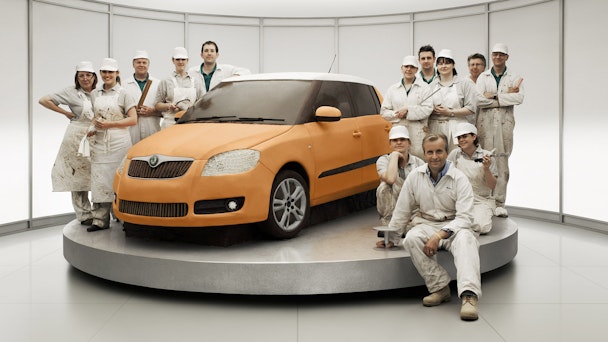Why are car ads running on an empty creative tank?
Jon Evans, chief marketing officer of System1, takes a look at why car ads are scoring so poorly on its software designed to rank creative.

Skoda’s 2007 ‘Cake’ ad still scores five stars today
The British motorist is not having a great 2021. Record fuel prices, road-blocking protesters, green guilt and empty pumps are combining to make driving a joyless, barely functional experience. And car ads have been well ahead of trend, scoring modestly on effectiveness and failing to spark much emotional response in viewers on our Test Your Ad database. It doesn’t have to be this way.
From VW’s classic ‘Small is Beautiful’ print ad to Renault’s ‘Papa and Nicole’ campaign of the 1990s, car ads are still held up as great examples of how to make witty, memorable and effective work. But their 2021 equivalents aren’t in the same lane. One of the only recent UK car ads to score four stars or more on System1’s five-star scale is a remake of Honda’s classic ‘Cog’ done at home during the pandemic. It’s a truly charming work – but how damning is it that almost no modern car ad can touch an amateur remake of one of the category greats?
Of course, the same database lets us know that most ads in most categories aren’t much good – around 50% of all video ads score the lowest one-star effectiveness rating.
But most of them boast one or two stand-out brands, managed by marketers who know how to hit the effectiveness sweet spot and regularly top the Test Your Ad rankings. In video games, it’s Nintendo. In insurance, it’s Compare The Meerkat. Even the humble loaf of bread – the most basic imaginable category – has Warburtons’s tongue-in-cheek epics and Hovis’s evocative slices of the past. But for car brands in the UK, nobody stands out – almost all the Top 20 advertisers average the same modest one-star score.
The arguments for making great car ads are as strong as ever. It’s one of the biggest purchases you make, it’s a choice that’s publically visible and makes a statement about who you are and what you value, and because it’s a decision you rarely make it’s crucial for marketers to build long-term positive brand associations. None of that has changed. So what is it about cars that holds brands back?
There are three problems:
Caution
There is too much caution. Overall car sales have been flat or in decline for a few years, and that creates a risk-averse mentality, which can lead to conservative ads. There’s been plenty of innovation at the sales end of the pipeline – with digital showrooms, customization apps and virtual test drives all growing – but very little at the brand-building stage.
Category codes
The second issue is that automotive ads have very strong category codes. We can all imagine the generic car ad – rainy neon-lit night drives, top-down shots of mountain and forest roads, thrilling close-ups of wheels, and so on. There are so many cliches to choose from that in 2018 Lexus got an AI to script a car ad and the computer still managed to outscore 70% of the System1 database.
Risk-averse marketers and rigid category codes are a recipe for generic ads, and that’s what we often see.
Too feature-led
The third issue is that car brand ads are often very feature-led – electric vehicles, on-board driver assistance and other technological advances. It’s understandable brands want to shout about those things, but ads that focus on features often leave little room for storytelling and emotion.
The good news is that all these issues have solutions, and we can point to good examples of car ads that handle them well.
Let’s start with features. It can be tough to turn a feature into the hook for a story, but it’s very possible. In 2016, Volkswagen made a German commercial for its Tiguan brand that focused on its automatic parking capabilities. Not very entertaining, you might think. But the ad was a big hit and a five-star winner in testing because it showed horses rolling about laughing at a bad parker. ‘Laughing Horses’ took the oblique route to showing off its features and was far better because of it.
What about category codes?
Take a look at the ‘Cake’ ad from Skoda in 2007, which we retested last year – it still got five stars. Like Honda’s ‘Cog’, it breaks every car ad convention, showing instead a team making a scale model cake of a Skoda. And people loved it – it got five stars when we first tested it, its quirky approach sparking real joy. The benefit of rigid category codes is that it’s far easier to be truly distinctive by stepping outside them.
Finally, that cautious marketing mindset. This is the hardest problem to tackle, but there’s plenty of evidence to show that long-term thinking and ads that look to entertain are good for brand-building and business growth. Suzuki’s mid-2010s partnership with ITV and Ant and Dec was a great example of this – engaging ads that tested well and worked as a series over the long-term. Ant McPartlin’s drink-driving conviction brought the sequence to an abrupt end, but the brand’s approach was spot-on.
The work of System1’s Orlando Wood, in his bestselling book Lemon (named after a classic VW print ad) and its imminent sequel, gathers the evidence for brand-building and longer-term thinking. Wood brings together proof from marketing science and neuroscience showing that humor, strong characters, catchy songs, narratives and other elements can be of huge benefit in engaging people and winning their attention. These things are hardly radical, but in the generic production line of car adverts they could be highly distinctive. The category needs that kind of boldness to move up a gear.
